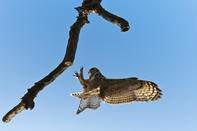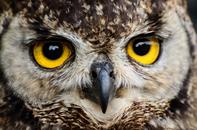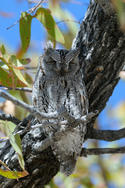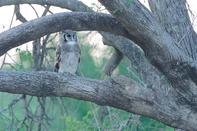Masters of Silent Flight
Owls are masters of silent flight. This skill is necessary so that they can listen for the sounds of their prey while they’re in flight and also so that they have the stealth required to surprise and capture prey. Silent flight is achieved in two simple ways.

Owls have very large wings relative to the size and mass of their bodies. This gives them a low wing loading and allows them to fly without having to flap excessively. The leading edge of an owl’s wings has velvety feathers that are ‘frayed’. This splits up the passage of air hitting the edge of the wing and effectively omits the slicing sound associated with other birds in fast flight.
Enhanced Vision

Owls do not essentially have better eyes than humans in that they can see the same spectrum of light that we can. An owl’s eyes are however designed to collect more light than humans by having a long optical axis and a much curved cornea and they are thus able to construct brighter images for enhanced vision in low-light conditions. The eyes are very large with widely-dilating pupils. They are well stocked with rod cells (light sensitive cells) and are subsequently very sensitive to movement. Neither owls nor any other birds can see in total darkness but some species of owl can see so well in low-light conditions that they can detect dead prey in weak starlight.
Owls enjoy excellent binocular vision because they have the most forward facing eyes of all birds affording them a 70 degree overlap. Their eyes are large which helps with collecting light but the size restricts their mobility in the skull and owls only have a total visual field of 110 degrees, birds with peripheral vision from side-placed eyes enjoy up to 340 degree fields of vision. To overcome this, owls have very flexible necks which allow them to turn their heads 270 degrees enabling them to even see behind them.
Such contortion of the neck would usually cut off the blood supply to the head by pinching closed the main artery, but owls have two such arteries, one on either side of the neck, which provide an uninterrupted blood supply to the brain during neck twists.
Owls are often seen bobbing their heads when staring at objects. This is a secondary technique that they use to work out the relative positions of objects to one another and this helps them to gauge distance.
Ear, Ear!

The feathers that stand erect on top of some owls’ heads are known as ear tufts. These are not real ears and have a camouflaging function. During the day when owls are attempting to blend into their surrounds to remain unnoticed while they rest, they will erect their ear tufts to help break the outline of their bodies and thereby be more camouflaged.
The African scops-owl does this especially successfully and its ear tufts help it to mimic pieces of bark or lichen. When owls are nesting (those that don’t use holes), they will lie flat on their bellies and also erect the ear tufts to break their outline. In order for this kind of crypsis to be successful, owls have mastered the art of sitting still.
To compliment their eyesight, owls have especially acute hearing. Owls can detect sounds made by small mammals and insects in the ultrasonic spectrum, higher pitched but not necessarily softer than the human ear can detect. Some species have asymmetrically placed ears that allow a split second difference in the reception of sound in each ear and this allows owls to pinpoint sound precisely, a key feature required to catch prey in total darkness.
The ears are positioned on the edge of the facial disc (most prominent in the barn owls) and this facial disc acts like a parabola to focus especially the more high-pitched sounds into the eardrums. These high pitched sounds are further enhanced by air spaces that inter-connect the ears.
Feathers surrounding the ear openings are soft and don’t interfere with incoming sound waves. Barn owls also have a movable flap of skin (an operculum) that helps them direct sounds coming from behind into their eardrums.
A Big Swallow

Owls generally swallow their food whole. The Verreaux’s eagle-owl has the most voracious diet of the owls easily taking prey up to the size of scrub hares and vervet monkeys. They will pull this larger prey apart but will not necessarily pluck it first. An owl can use its zygodactylous feet in the same fashion a parrot can, lifting the foot to the mouth.
All the indigestible bits of bone and fur are regurgitated in a mucous covered ball known as a pellet. This is necessary because the food isn’t chewed and the large particles can not clear the pyloric opening between stomach and intestine.
By Megan Emmet